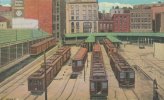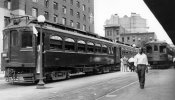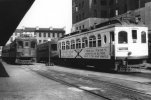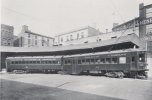Jasper
Hey, I'm only being creative here!
In a book I came across this photo of the Interurban station in Baltimore. Online, I could find hardly anything about this station, so I've tried to photograph the photo for you:

As I see it, there are two stub-ended island platforms, and a longer platform on the loop at the far end. (I have used the word "platform" a bit loosely here, for these roofed passenger areas may have had a floor height equal only to the top of the rail.)
Seems to me that some poles do double duty, carrying both the platform roof and the overhead. Also, on the tracks leading to one of the stub platforms, there's something dark between the rails. Does anyone know what it could be? Presumably it's on other tracks as well, where you can't see.
It's feasible to build this station with R1 curves and turnouts. It would make an interesting model with all sorts of operation potential. It could be one end of a single track or double track line, or you could have a fiddle yard. I know the WB&A, which ceased operation in 1935, ran both local and express services for passengers, and I imagine the loop being used for the express services.


As I see it, there are two stub-ended island platforms, and a longer platform on the loop at the far end. (I have used the word "platform" a bit loosely here, for these roofed passenger areas may have had a floor height equal only to the top of the rail.)
Seems to me that some poles do double duty, carrying both the platform roof and the overhead. Also, on the tracks leading to one of the stub platforms, there's something dark between the rails. Does anyone know what it could be? Presumably it's on other tracks as well, where you can't see.
It's feasible to build this station with R1 curves and turnouts. It would make an interesting model with all sorts of operation potential. It could be one end of a single track or double track line, or you could have a fiddle yard. I know the WB&A, which ceased operation in 1935, ran both local and express services for passengers, and I imagine the loop being used for the express services.





